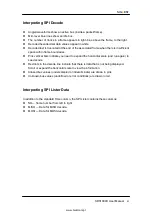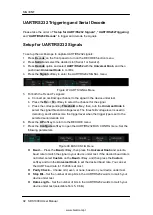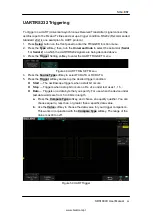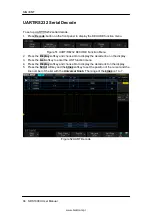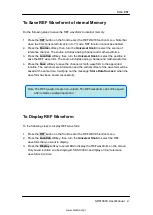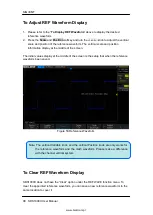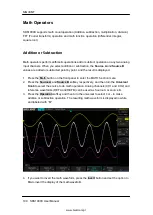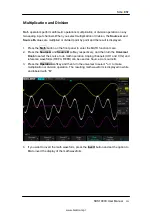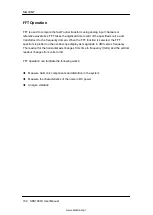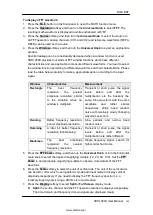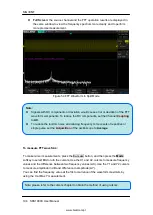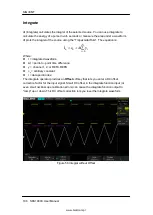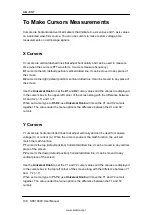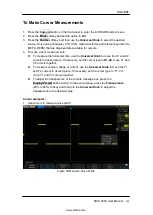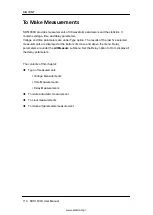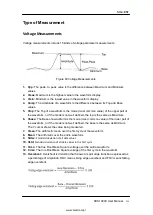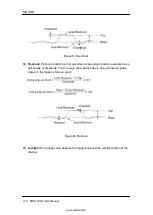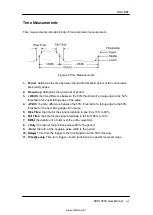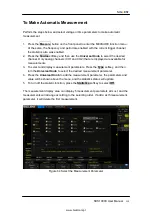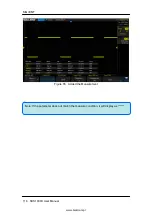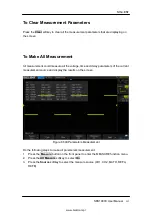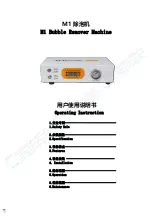
SIG
L
ENT
SDS1000X User Manual
103
To display a FFT waveform:
1. Press the
Math
button on the front panel to open the MATH function menu.
2. Press the
Operation
softkey and then turn the
Universal Knob
to select
FFT
. The
resulting math waveform is displayed in white and labeled with ―M‖.
3. Press the
Source
softkey, and then turn the
Universal Knob
to select the source to
do FFT operation. Analog channels (CH1 and CH2) and reference waveforms (REFA,
REFB) can be used as the source.
4. Press the
Window
softkey, and then turn the
Universal Knob
to select an appropriate
window.
Spectral leakage can be considerably decreased when a window function is used.
SDS1000X provides four kinds of FFT window functions which have different
characteristics and are applicable to measure different waveforms. You need to select
the window function according to different waveforms and their characteristics. Please
read the table below carefully to make a appropriate option according to the input
signal.
Window
Characteristics
Measurement
Rectangle
The
best
frequency
resolution;
the
poorest
amplitude resolution; similar
to the situation when no
window is multiplied.
Transient or short pulse, the signal
levels
before
and
after
the
multiplication are the basically the
same; Sine waveform with the same
amplitude
and
rather
similar
frequencies; Wide band random
noise with relatively slowly changing
waveform spectrum.
Hanning
Better frequency resolution;
poorer amplitude resolution.
Sine, periodic and narrow band
random noise.
Hamming
A litter bit better frequency
resolution than Hanning.
Transient or short pulse, the signal
levels
before
and
after
the
multiplication are rather different.
Blackman
The
best
amplitude
resolution;
the
poorest
frequency resolution.
Single frequency signal, search for
higher order harmonics.
5. Press the
FFT Zoom
softkey, and then turn the
Universal Knob
or turn the horizontal
scale knob to select the desired magnifying multiple (1X, 2X, 5X, 10X). Set the
FFT
Zoom
to an appropriate magnifying multiple to observe more details of the FFT
waveform.
6. Press the
Scale
softkey to select the unit of vertical axis. The unit of the vertical axis
can be dB or Vrms which use logarithmic mode and linear mode to display vertical
amplitude respectively. If you need to display the FFT frequency spectrum in a
relatively larger dynamic range, dBVrms is recommended.
7. Press the
Display
softkey
to select
Split
or
Full Screen
display mode.
Split:
the source channel and the FFT operation results are displayed separately.
The time domain and frequency domain signals are displayed clearly
www.biall.com.pl
Summary of Contents for SDS1102X
Page 2: ...www biall com pl...
Page 19: ...SIGLENT SDS1000X User Manual XVII www biall com pl...
Page 20: ...www biall com pl...
Page 89: ...SIGLENT SDS1000X User Manual 69 Figure 28 Relative Window Trigger www biall com pl...
Page 91: ...SIGLENT SDS1000X User Manual 71 Figure 29 Interval Trigger www biall com pl...
Page 95: ...SIGLENT SDS1000X User Manual 75 Figure 32 Runt Trigger www biall com pl...
Page 109: ...SIGLENT SDS1000X User Manual 89 Figure 44 SPI Trigger www biall com pl...



